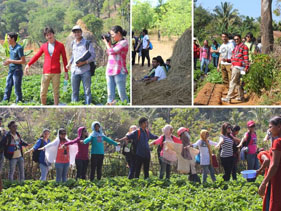An Indian perspective on ecotourism

Goan couple offer massive warm hospitality in exchange for tiny payment
A sense of confidence and contentment is writ large on the faces of Suresh and Sangeeta Gaonkar from Verlem, a tiny hamlet located in the Netravali wildlife sanctuary. Writes Govind Kamat Maad in the Times of India
The tribal couple recently played perfect hosts to a Russian woman in their humble dwelling, and their hospitality has floored their foreign visitor—the reason for their new found joy.
"I was extremely lucky to have this experience to be a part of this life even for two days. I was so warmly welcomed here, and I feel as a part of the family even though I didn’t have the knowledge at all. Thank you for this project. Hope to keep in touch and to be back here soon," wrote their guest, Taliana Varfoloveera, in the comments book before taking the Gaonkar couple’s leave.

The Gaonkar couple is raring to welcome more such guests, to offer them a slice of a truly rural home stay experience amidst the serene mountains of South Goa.
"Though language was a barrier in communicating with the Russian guests they enjoyed interacting with hand gestures. "Though most Russians don’t know English, this woman is an English teacher, and I would sometimes serve as an interpreter for the host and the Russian guest," explains Suchita Gaonkar, an affable young lady who mans the welcome centre of ‘Aangan’ village stay initiative.
Designed on the lines of a cooperative model, ‘Aangan’ is a part of a community based eco-tourism project that was launched some three months ago. The project is owned and operated by the Verlem Ecotourism Co-operative Society (VECS) which comprises members belonging to the local community. Mineral Foundation of Goa (MFG) has provided technical, moral as well as a "little bit of" financial support for the project.
Verlem has a population of 450, with 95 houses. It is a hotspot of biodiversity and a favourite trekking spot for wildlife enthusiasts and birders. Already, 27 visitors from various parts of India as well as abroad have savoured the home stay experience during the monsoons — that time of the year when nature is at its magical best. The bewitching beauty of the hills, the serene vistas of the hamlet, and the gushing waterfalls during the rains, leave one mesmerized and refreshed.
Explaining the economics of the project, office bearers of the MFG who have been closely associated with the project, said that the tourists are charged `900 per person per night (£9, €11, $15) for the package which includes, besides accommodation, two meals, breakfast and tea, and guide charges. "Out of the `900, the home stay owner is paid `500, while the guide gets `300 for his services. We have imposed certain restrictions and controls to ensure that the project retains its inherent rustic character and doesn’t end up as a run-of-the-mill commercial venture. For instance, the no-alcohol policy ensures that the guests are not troubled by any nuisance created by intoxicated tourists.
The project is designed to target some specific categories of tourists — families who would like to experience a pure countryside holiday destination; groups of trekkers, birdies and nature enthusiasts; and groups on educational tours keen on exploring nature. The society has tied up with a couple of tour operators who will ensure a steady flow of tourists," a MFG office bearer said. No separate cottages or rooms have been built for the home stay, except upgrading the existing wash room facilities and providing proper bed and linen in the guest room. The guest shares the same house and partakes of the food prepared by his host.
"Convincing the locals that no harm will be caused to their age-old religious beliefs and customs was the most challenging task. However, interacting with the locals has been a wonderful learning experience for us. The knowledge of the tribal folk about the wild shrubs and plants, including medicinal ones, is immense. In fact, we once savoured a dish of a species of mushrooms, the type which I had never seen before," said the mentor, an avid nature lover.
"After one successful season, more villagers have shown interest in strawberry cultivation. As monsoon has now come to an end, a new harvest of strawberry will soon begin blooming, explains Kalpesh Velip, a young local who also manages the affairs at the Aangan welcome centre.
So how does one ensure self-sustainability of this low-volume project?
"That remains a challenge, but we are confident that the volumes will steadily pick up. The basic principle underlying the ecotourism project is that the basic means of livelihood has not been replaced by the new eco-venture. Agriculture will continue to be the mainstay of the village economy, while the village stay project will be a supplementary source of income for the villagers," the mentor said, matter-of-factly.
The villagers are determined to take the project towards success. The grin on Sangeeta’s face and the silent song in Suresh’s heart says it all.
Source: Times of India
Great sustainable offers this week: 93% off reports and guides here Keys to sustainably successful destinations revealed here Going to WTM, want to attract high value green tourists? here
 United Kingdom
United Kingdom United States
United States Asia Pacific
Asia Pacific












































Dozens fall ill in P&O Cruises ship outbreak
Turkish Airlines flight in emergency landing after pilot dies
Boy falls to death on cruise ship
Unexpected wave rocks cruise ship
Woman dies after going overboard in English Channel